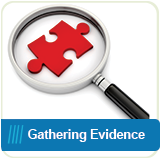Gathering Evidence
Key Message

 Effective practice relies on robust, reliable and
relevant evidence. This may come from a variety of sources. The
first step in any project (audit, evaluation, service improvement)
is to gather all the evidence available from sources such as:
Effective practice relies on robust, reliable and
relevant evidence. This may come from a variety of sources. The
first step in any project (audit, evaluation, service improvement)
is to gather all the evidence available from sources such as:
- literature reviews - to outline what is known about the topic and any gaps in knowledge,
- audit, surveys, interviews, or focus groups.
- Data analysis follows data/evidence gathering to focus on the elicitation of findings, conclusions and recommendations for practice improvement.
You may wish to start by exploring this brand new resource designed to help you develop skills in effectively searching literature.
What does this mean for the Effective Practitioner?
The effective practitioner requires a variety of skills and tools to gather robust evidence. These include database searching skills, for example using the Knowledge Network to find peer-reviewed articles at the right level and nature of your project. It's important that a nurse, midwife and allied health professional is able to select the most suitable quantitative and qualitative methods to gather data and have the resources and skills to be able to analyse data either with a local clinical effectiveness department or through personally using data analysis tools such as MS Excel or SPSS.
![]() You can download a copy of
the Gathering Evidence
learning activities.
You can download a copy of
the Gathering Evidence
learning activities.
Reflection
Remember, recording your reflections is an important part of the learning process. Take time to structure your thoughts, feelings and any future actions on one the forms available in the Reflective Practice section. Click here to visit the page.
In your reflections you could also consider how your learning relates to the Clinical Practice, Facilitation of Learning and Leadership pillars of practice.
Return to topSignposts
![]() CASP (Critical
Appraisal Skills Programme)
CASP (Critical
Appraisal Skills Programme)
![]() Knowledge
Network: Finding Information
Knowledge
Network: Finding Information
![]() Flying Start NHS: Evidence, Research and Develepment unit
(TURAS login required)
Flying Start NHS: Evidence, Research and Develepment unit
(TURAS login required)

